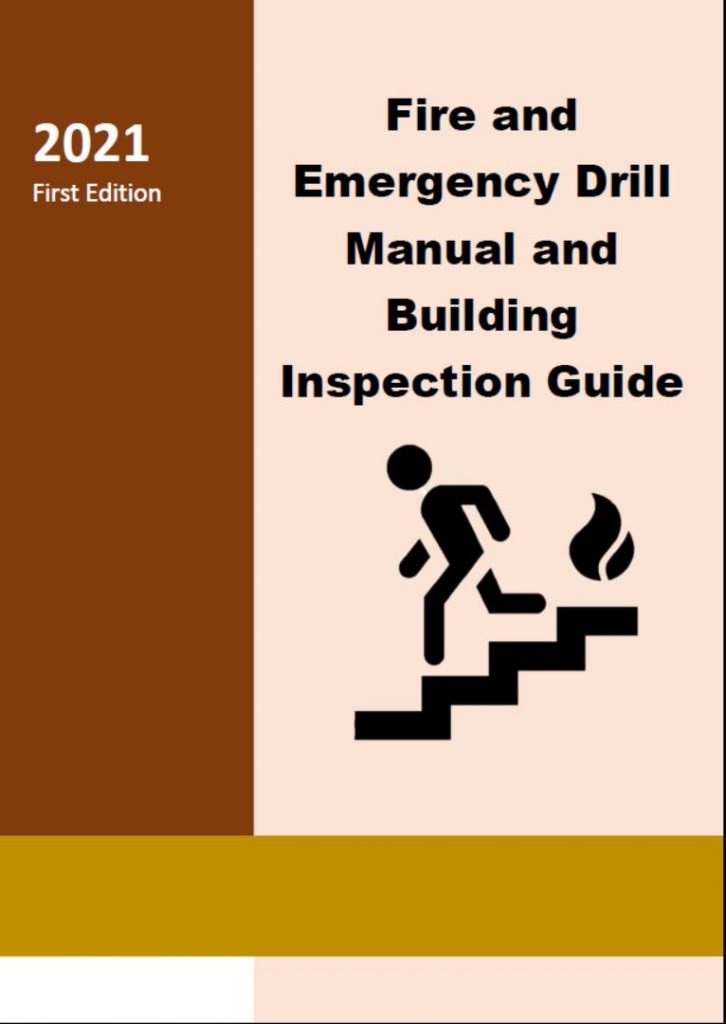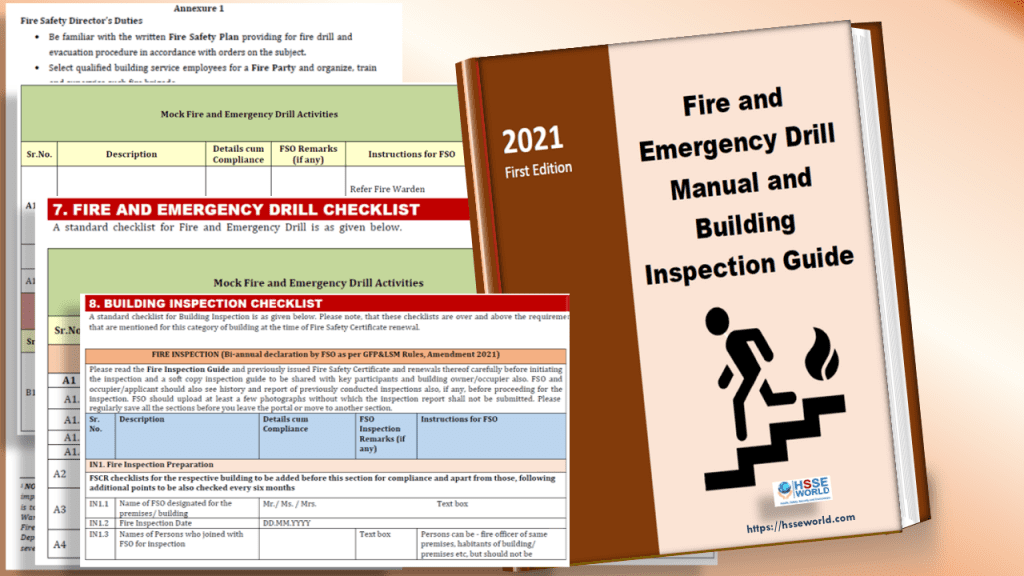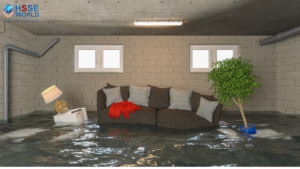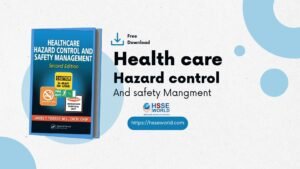E-Books: Fire and Emergency Drill Manual and Building Inspection Guide
7 min readFire and Emergency Drill Manual and Building Inspection Guide published :
- To suggest processes for the preparation, conduct and evaluation of drill.
- To serve as a guide for carrying out periodic inspection of building/premise.
National Building Code 2016 (Part 4: Fire and Life Safety) and the Fire Prevention and Life Safety Measures Regulations, 2021 has specified comprehensive measures for Fire Prevention, Life Safety and Fire Protection in various categories of buildings. These measures are based on the types of occupancies, fire load, occupant load, etc. in the given building. However, it is essential that all the occupiers of the building/ premise are well-versed with all the potential hazards, use of firefighting installations and signage. They also need to be aware about their respective roles and responsibility in case of a fire or emergency and have skills and competencies required for life safety in case of any incidents.
Fire and emergency drill and regular building inspection are effective ways to enhance preparedness for response and prevent untoward incidences. The Fire Prevention and Life Safety Measures Regulations, 2021 mandates that building inspection for fire safety related aspects and mock-drills should be conducted every six months. They help in securing the building from a potential hazard and also facilitate to test the capacities of the occupiers. They also help in identification of gaps through feedbacks which results in potential saving of lives and property in case of fire incidence.

Preparation of Fire Safety Plan
Preparation of a Fire Safety Plan is the first step towards prevention and management of fire risk in the building/ premise. Fire Safety Plan should be prepared by the building owner/occupiers to guide the building/ premise occupiers to prepare for any eventualities and respond in the event of fire and evacuate the building/ premise in the shortest available time. The plan would further guide the owners/ occupiers to take necessary measures for Fire Prevention, Life Safety and Fire protection.
The applicable parts of the approved Fire Safety Plan shall be distributed to all the owners/occupiers of the building by the building management when the Fire Safety Plan has been finalized.( learn more:fire-emergency-evacuation-plan-and-the-fire-procedure/)

Building Fire Safety Team Formation
The building owner/ occupier should form a Building Fire Safety Team of competent personnel/ occupiers to prepare and executive the provisions of Fire Safety Plan. The team may comprise of the following:
- Fire Safety
Director
- Deputy Fire Safety Director
- Fire Wardens and Deputy Fire Wardens
- Building Evacuation Supervisor
- Fire Party
The duties (roles and responsibilities) of the above mentioned team members are given in Annexure-1.
An Organization Chart designating employees and their assignments/ role as one of the team members is required to be prepared for clarity and should be share with all building occupiers and staff in soft or hard copy. During mock fire and emergency drill, a Fire Safety Officer (FSO) has to check details of the Organizational Chart and Fire Safety Plan.
Capacity Building and Training of Building Occupiers
To build the competency of the above team and occupiers, Building Fire Safety Team should organize capacity building programs on the following lines:
- Preparation of Fire Safety Plan
- Evacuation procedures
- Handling of firefighting equipment like fire extinguishers
- Maintenance of firefighting instruments
- Following exit routes and identifying emergency and exit signages
- Organize training sessions in basic fire safety
Scenario Building
A fire and emergency scenario provides the backdrop and storyline that drive the mock drill. It is important to build a scenario as it provides a guidance mechanism for planning of various response procedures required to reduce the response time. A scenario should be built for the building in a mutually consultative manner by the Fire Safety Officer (FSO) and Building Fire safety Team. IN every mock drill, a different scenario should be built.
The first step in conducting a drill is to define a broad scenario outline that reflects and supports the various objectives of the drill.
Depending on the scope, the scenario may need to be divided into several phases, each focused on a particular aspect of the Fire Prevention, Life Safety and Fire Protection.
A general outline of the scenario
should include, but not be limited to, the following:
- Drill Narrative – The drill narrative of the scenario is a brief overview that is often provided to describe the events involved in the scenario. It is a ‘story’ that contains all the main events that will drive the drill. This description of the scenario is provided mainly for the drill personnel and organizers who may lack the technical incentive, background or knowledge to understand the more technical scenario.
Tactical Description
The tactical description gives details as to the situation of adversarial actions and the events that set the scene for the drill event. This includes, for example:
- Initiating event (e.g. short circuit, cylinder explosion, gas leak, etc.);
- External variables that contribute to or diminish response team ability to accomplish tasks
Start State (initial conditions)
The start state describes the initial conditions as well as the context for the exercise and reflects realistic conditions. The amount of detail provided should be limited to that actually necessary for conducting the remainder of the scenario.
- The characterization of the threat;
- The types and status of equipment;
- The weather conditions;
- The operating environment;
3.4 Mock Drill Scheduling
The drill instructions should include a schedule detailing the timings for:
- Start (start of the drill)
- End (end of the drill)
- Briefings (briefing before the drill)
- Debriefings (briefing after the drill)
- Any other essential timing
The Fire Safety Compliance Portal shall have these events pre-scheduled in the system and the users and the Fire Safety Officers should follow the instructions as prompted by the portal.(learn more:importance-of-mock-drill-and-fire-action-emergency-procedure/).
Engaging an Observer for Evaluation
Evaluation process is an important component of the drill. It is the act of observing and recording mock drill activity, by comparing the performed actions against the drill objectives.
Evaluation serves following three functions:
- To evaluate personnel actions
- To evaluate the ability of the responding agencies to implement a plan.
- To check the effectiveness of the standard operating procedures
During the exercise, the role of the observer is to observe and record facts on the organizations’ response to the emergency. In general, Observer should be thoroughly familiar with the following:
- Occupancy specific fire safety measures and contingency response actions (e.g. security plan, contingency plan, procedures)
- Purpose and objectives of the drill
- Scenario events and scenario timeline
- Evaluation techniques
- Procedures for monitoring and tracking player actions
- Procedures for recording observation of player actions and feedback
- Procedures for reacting to player enquiries
Observers should take notes during the exercise and participate in the production of the final evaluation reports and share findings with the Fire Safety Officer (FSO). The record of actions is the key to a good evaluation. Good chronological notes should be taken concentrating on aspects that are critical to the response. Fire Safety Officer (FSO) should brief the observer(s) about above details.( click below to complete and download the manual ) ( have a copy of : fire-safety-logbook-templates/
Contents
The Contents of Fire and Emergency Drill Manual and Building Inspection Guide
- INTRODUCTION…………………………………………………….. 2
- SCOPE AND PURPOSE OF THE MANUAL………………….. 2
- FIRE AND EMERGENCY DRILL PLANNING AND PREPARATION………………………………………………………. 2
- PROCEDURE FOR FIRE AND EMERGENCY DRILL CONDUCTION………………………………………………………… 5
- DRILL EVALUATION AND CLOSING…………………………. 6
- INSPECTION OF BUILDING FOR FIRE SAFETY…………. 7
- FIRE AND EMERGENCY DRILL CHECKLIST……………… 8
- BUILDING INSPECTION CHECKLIST………………………. 21
- Annexure 1 – Responsibilities of Building Fire Safety Team Members
Download the book
Fire and Emergency Drill Manual and Building Inspection Guide
More Downloads
- E-Books: Healthcare Hazard Control & Safety Management
- E-Books: Safety, Health and Working Conditions Training Manual
- E-Books: Energy Efficiency in Water and Wastewater Facilities
- E-Books: Fire Service Features of Buildings and Fire Protection Systems
- E-Books: Evaluation of Fire Safety free download
- E-Books: PPE for Chemical, Biological, and Radiological Hazards free
- E-Books: Changing the Workplace Safety Culture free download
- E-Books: Site Emergency Planning Workbook
- E-Books: Load Restraint Guide
- E-Books: Essential Practices for Creating, Strengthening, and Sustaining Process Safety Culture
- E-Books: System Safety Engineering and Risk Assessment
- E-Books: Permit-Required Confined Spaces
- E-Books: Is it Safe to Enter Confined Space?
- E-Books: 5-Minute Workplace Safety Talks
- E-Books: Safety Culture and High-Risk Environments
- E-Books: Practical Guide to Industrial Safety
- E-Books: Slip, Trip, and Fall Prevention for Healthcare Workers
- E-Books: Health and Safety at Work Key Terms
- E-Books: Fundamentals of Process Safety Engineering
- E-Books: Gas Detection Hand Book
- E-Books: Occupational health and safety management systems ANSI-AIHA-z10-2012
- E-Books: Hot Work on Drums and Tanks
- E-Books: Human Fatigue Risk Management
- E-Books: Guidelines for the provision of facilities and general safety in the construction industry
- E-Books: Handbook of Training in Mine Rescue and Recovery Operations ( 2021)
- E-Books: Code of Practice for the Safe Use of Lifting Equipment – Edition 9 (Nov 2019)
- E-Books: Free Forklift Health and Safety Best Practices Guideline
- E-Books: Handbook of Hazardous Chemical Properties
- E-Books: Human Performance Improvement through Human Error Prevention
- E-Books: Principles Of Fire Risk Assessment In Buildings
- E-Books: Investigation of Occupational Accidents and Diseases
- E-Books: Radiation Protection and Safety in Industrial Radiography
- E-Books: Basic Guide to System Safety, Third Edition
- E-Books: Food Safety Management-A Practical Guide for the Food Industry
- E-Books: Safety identification: Escape and evacuation plan signs- ISO 23601
- E-Books: Safety at Work
- E-Books: The Safety-Critical Systems Handbook 4th edition
- E-Books: Fundamental principles of occupational health and safety
- E-Books: Fire Safety Risk assessment Guide – Sleeping Accommodation
- E-Books: Mental health at work series
- E-Books: Live Fire Training: Principles and Practice
- E-Books: Pre-Startup Safety Review Guide
- E-Books: Fire and Emergency Drill Manual and Building Inspection Guide
- E-Books: Health and Safety: Risk Management 5th edition
- E-Books: Fire Protection systems -Third edition 2021
- E-Books: Fire Safety Logbook templates
- E-Books: From Accidents to Zero
- E-Books: Electric Safety Practice and Standards
- Your steps to chemical safety
- E-Books: Ergonomics and Psychology Developments in Theory and Practice
- E-Books: HAZOPS Should BE fun-The Stream-Based HAZOP
- E-Books: Safety Health and Environmental Auditing
- E-Books: A Quick Guide to Health and Safety
- E-Books: Occupational Ergonomics A Practical Approach
- E-Books: Job Hazard Analysis A Guide for Voluntary Compliance and Beyond
- E-Books: Electrical Safety of Low Voltage Systems



